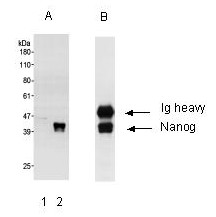SC1000 Sigma-AldrichAnti-Nanog Rabbit pAb
This Anti-Nanog Rabbit pAb is validated for use in Immunoblotting, Immunoprecipitation for the detection of Nanog.
More>> This Anti-Nanog Rabbit pAb is validated for use in Immunoblotting, Immunoprecipitation for the detection of Nanog. Less<<Synonyms: Anti-Nanog Homeobox, Anti-ENK, Anti-Early Embryo Specific Expression NK Family Gene
Recommended Products
Overview
| Replacement Information |
|---|
Key Spec Table
| Host |
|---|
| Rb |
| References | |
|---|---|
| References | Chambers, I., et al. 2003. Cell 113, 643. Mitsui, K., et al. 2003. Cell 113, 631. Pan, G.J. and Pei, D.Q. 2003. Cell Res. 13, 499. |
| Product Information | |
|---|---|
| Form | Liquid |
| Formulation | In Tris-citrate/phosphate buffer, pH 7.0-8.0. |
| Positive control | Mouse myeloid embryonic stem cells |
| Preservative | ≤0.1% sodium azide |
| Quality Level | MQ100 |
| Physicochemical Information |
|---|
| Dimensions |
|---|
| Materials Information |
|---|
| Toxicological Information |
|---|
| Safety Information according to GHS |
|---|
| Safety Information |
|---|
| Product Usage Statements |
|---|
| Packaging Information |
|---|
| Transport Information |
|---|
| Supplemental Information |
|---|
| Specifications |
|---|
| Global Trade Item Number | |
|---|---|
| Catalogue Number | GTIN |
| SC1000 | 0 |
Documentation
Anti-Nanog Rabbit pAb Certificates of Analysis
| Title | Lot Number |
|---|---|
| SC1000 |
References
| Reference overview |
|---|
| Chambers, I., et al. 2003. Cell 113, 643. Mitsui, K., et al. 2003. Cell 113, 631. Pan, G.J. and Pei, D.Q. 2003. Cell Res. 13, 499. |
Brochure
| Title |
|---|
| Stem Cell Resource Brochure GBP |







